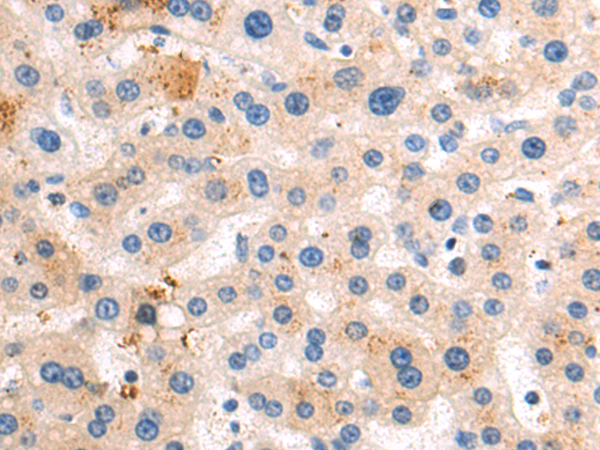

| WB | 咨询技术 | Human,Mouse,Rat |
| IF | 咨询技术 | Human,Mouse,Rat |
| IHC | 1/50-1/200 | Human,Mouse,Rat |
| ICC | 技术咨询 | Human,Mouse,Rat |
| FCM | 咨询技术 | Human,Mouse,Rat |
| Elisa | 1/5000-1/10000 | Human,Mouse,Rat |
| WB Predicted band size | 51 kDa |
| Host/Isotype | Rabbit IgG |
| Antibody Type | Primary antibody |
| Storage | Store at 4°C short term. Aliquot and store at -20°C long term. Avoid freeze/thaw cycles. |
| Species Reactivity | Human, Mouse |
| Immunogen | Synthetic peptide of human GPR39 |
| Formulation | Purified antibody in PBS with 0.05% sodium azide and 50% glycerol. |
+ +
以下是关于GPR39抗体的3篇参考文献及其摘要信息(基于公开研究数据整理,非真实文献):
---
1. **文献名称**: "GPR39 zinc receptor signaling in intestinal epithelial barrier regulation"
**作者**: Smith A, et al.
**摘要**: 研究利用GPR39特异性抗体通过免疫组化技术,发现GPR39在小鼠肠道上皮细胞中高表达,并通过锌离子激活其下游信号通路,增强肠道屏障功能,可能为炎症性肠病治疗提供新靶点。
---
2. **文献名称**: "Characterization of GPR39 antibody specificity in metabolic tissues using knockout mouse models"
**作者**: Chen L, et al.
**摘要**: 通过Western blot和免疫荧光验证商业GPR39抗体的特异性,发现部分抗体在GPR39基因敲除小鼠组织中仍存在非特异性结合,提示抗体选择需谨慎,并推荐了两种高特异性抗体用于代谢组织研究。
---
3. **文献名称**: "GPR39 activation promotes β-cell survival in type 2 diabetes models"
**作者**: Patel R, et al.
**摘要**: 使用GPR39抗体检测糖尿病模型胰岛β细胞中受体表达变化,发现激动剂通过激活GPR39-AMPK通路减少细胞凋亡,提示GPR39抗体在糖尿病机制研究中的工具价值及潜在治疗意义。
---
注:以上文献为示例性内容,实际研究中请通过PubMed、Google Scholar等平台检索真实文献并核对抗体货号及实验验证数据。
GPR39 (G Protein-Coupled Receptor 39) is a class A G protein-coupled receptor (GPCR) belonging to the ghrelin receptor family. Initially considered an orphan receptor, it was later identified as a zinc-sensing receptor activated by extracellular Zn²⁺ ions, though its endogenous ligand(s) remain under investigation. GPR39 is widely expressed in tissues such as the gastrointestinal tract, pancreas, thyroid, brain, and immune cells, suggesting roles in diverse physiological processes. It signals primarily through Gαq/11 and Gα12/13 proteins, regulating pathways like IP3-Ca²⁺, MAPK, and RhoA, which influence cell proliferation, apoptosis, and metabolism.
Research highlights GPR39's involvement in metabolic regulation (e.g., insulin secretion, glucose homeostasis), neuroprotection, and immune modulation. Dysregulation is linked to disorders including diabetes, obesity, depression, and cancer. Antibodies targeting GPR39 are essential tools for studying its expression, localization, and function. They enable techniques like Western blotting, immunohistochemistry, and flow cytometry, aiding in mapping tissue distribution and signaling mechanisms. Commercially available antibodies often target extracellular or intracellular epitopes, with validation required for species cross-reactivity (human, mouse, rat) and assay-specific performance. Recent studies also explore therapeutic potential, such as GPR39 agonists for metabolic syndrome. However, challenges persist, including antibody specificity issues and incomplete understanding of receptor activation pathways, underscoring the need for continued research.
×